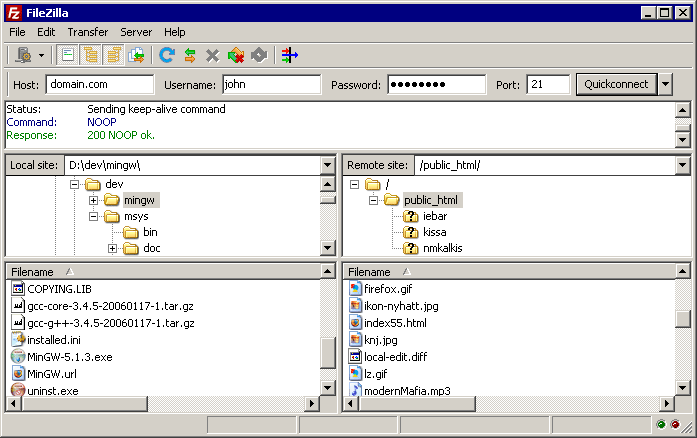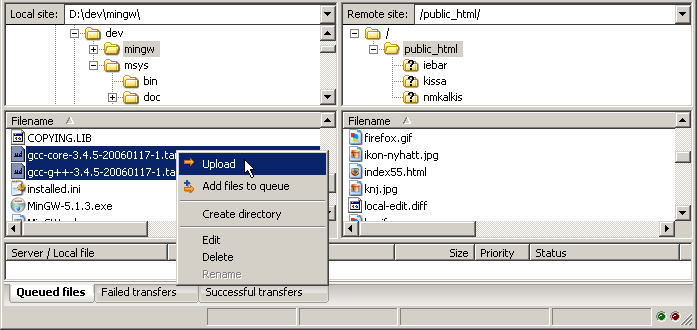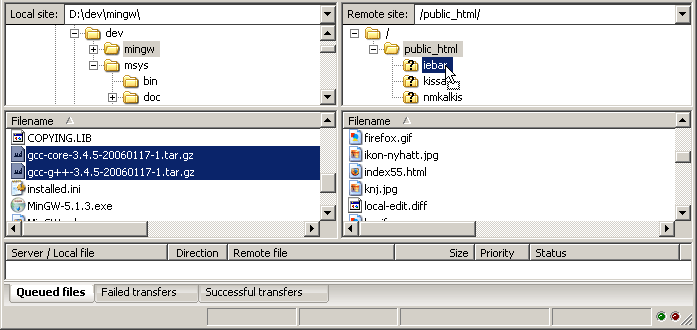Using
Quick Guide
This guide gives you a short overview on how to use FileZilla. By default you don't have to configure FileZilla, so you can start directly working with the program.
bir FTP sunucusuna bağlanma
Quick Connect bar kullanma
Bir FTP sunucusuna bağlanmak , Quickconnect bar (yani domain.com - bkz aşağıdaki resimde ev sahibi alanına sunucunun adresini girin) için. bir SFTP sunucusu gibi özel bir sunucu türü ise, adres önünde protokol ekleyin. bir SFTP sunucusu durumunda, sftp 'ile adres başlatın: / / ' (yani sftp : / / domain.com ). o ise yok varsayılan portu ( 21 FTP, 22 SFTP için liman alanına ) sunucunun port numarasını girin. bir kullanıcı adı / şifre gerekli ise , ilgili alanlarda , aksi halde kullanılacak varsayılan adsız logon girin. Tıklayın Quickconnect veya basın sunucusuna bağlanmak için girin.
File:- info.png girin
Lütfen dikkat edin Quick Connect için ... hızlı bağlantı - böylece herhangi bir şekilde son 10 giriş mağazaları hızlı bağlantılar listesini değiştirmek daha kolaydır. Sunucu FTP mağaza size Şantiye Şefi, yerine kullanmalıdır isimler için.
Quick Connect iyi bir site yöneticisi giriş yapmadan önce giriş bilgilerinin test içindir. Bir kez bağlandığınızda, Dosya seçebilirsiniz -> "Copy mevcut bağlantı Site Yöneticisi için ... " kalıcı bir giriş yapmak . Genellikle en iyi kalıcı bir giriş yapmadan önce Quick Connect ile giriş bilgilerinin kontrol etmektir.
kullanarak Site Yöneticisi
Belirli site parametrelerini belirlemek ve hedeflenen FTP siteye bağlanmak FileZilla [ [Site Yöneticisi ]] kullanabilirsiniz. [ [Site Yöneticisi ]] size kayıtları saklamak ve Quick Connect daha parametrelerini konfigüre izin verir .
Özel durum: Sunucular LAN
sunucu bağlanıyorsanız ev LAN , sonra orada bir adresi ( alan adı) Internet'ten Bildiğiniz gibi değildir. LAN , sen sadece sunucu bilgisayarın iç IP adresini kullanın. Çoğu ağ adı ( bilgisayar ismi ) yapacağım de. Sunucu Filezilla aynı bilgisayarda ise, hatta hostname olarak localhost veya 127.0.0.1 kullanabilirsiniz.
NOT : Eğer LAN dışından bu geçerli değildir bağlantı varsa, (WAN) IP yerine harici kullanmak zorunda .
After a successful connection attempt, a list of files and folders appears on the right side of the main window. The current folder is listed in the edit field on the top. Below you will see the remote directory tree and below that, the contents of the current remote folder. There are three ways to change the folder. First, you can double-click a folder in the file list. Second, you can change the current folder by clicking a folder in the directory tree. Last but not least, you can always enter the folder name into the edit field and press enter. You will notice a folder called ".." displayed in virtually all directories. This folder allows you to go up to the parent directory of the current folder.
Navigating on your machine works almost like navigating on the server. The current local folder and the local directory tree are displayed on the left side of the main window by default.
Synchronized Browsing
If you have an identical directory structure on the local machine and the server, you can enable synchronized browsing. This means that any directory navigation on one machine is duplicated on the other.
To enable synchronized browsing, create an entry in the Site Manager, and on the Advanced tab, ensure that the Default local directory and the Default remote directory have the same structure. Then check "use synchronized browsing," save your settings, and connect.
Directory Comparison
To quickly see differences between files on the local machine and the server, choose View > Directory Comparison, and choose either "compare file size" or "compare modification time." (You also hide identical files by checking that option.) Then choose "Enable."
You will now see color-coded differences between copies of the same file on the different machines. See their meanings here.
Transferring files
You can upload or download a file by double-clicking on it. It will be added to the transfer queue and the transfer starts automatically. To transfer folders and/or multiple files, select them and right-click the selection. Then you can click on Upload/Download in the popup menu.
You can also drag the files from one side and drop them on the other side. To add files to the queue so that they will be transferred later, select them and click Add to Queue from the popup menu. You may also drag the files directly into the queue. Click on the ![]() button on the toolbar to start the transfer.
button on the toolbar to start the transfer.
Or, you can click on a file, then drag the file (a box is added to the arrow cursor) to the folder where you want to move it. The folder will be highlighted when you are over it. Let go of the mouse button and the file will be moved to the folder.
Detailed Information Pages
Detailed information on other aspects of the FileZilla client can be found on the following pages:
File Transfer Notes
FileZilla uses multiple FTP sessions. One session gets used purely to browse the server. The other sessions get used to do the file transfers. That way, you can always browse the server even during transfers.
For example, here is a simple car analogy: You order a pizza using your telephone (aka the browsing connection), then you hang up the telephone. Then the delivery man drives the pizza in his car to your location (the transfer connection). While the pizza is transferring, you can phone somebody else, like for example your garage because your own car is broken ;)
Reducing simultaneous connections for incorrectly configured servers
If you get a 421 Too many connections from this IP (<number>) error, the FTP server is restricting your number of connections. There are even servers restricting it to one connection at a time.
The preferred solution would be to contact the server administrator and encourage him/her to configure the server correctly (FTP uses more than one connection by design!). But if you need access immediately, there is a workaround:
1. Open the Site Manager (File - Site Manager... or the first toolbar button)
2. Create an entry for that server, enter all details you know, the more precise, the better
3. Open the 'Transfer Settings' tab
4. Tick the 'Limit number of simultaneous connections' checkbox
5. Enter the desired limit into the 'Maximum number of connections' field
Now, if you connect using the Site Manager entry, connections will be limited.
Note: If you limit connections to 1 only, there is a major drawback: You cannot browse the server anymore while a transfer is in progress!
Troubleshooting
Re-registering the shell extension (Windows only)
Especially on Vista or Windows 7 it can happen that Drag&Drop fails and you get an error message stating the shell extension doesn't work. In this case you may need to re-register it. Here's how:
1. Open a command prompt as administrator. This is important!
Start Menu - All Programs - Accessories: Right Click 'Command Prompt', select 'Run as administrator'
2. Navigate to the Filezilla program directory.
Example (32bit): cd "\Program Files\Filezilla FTP Client"
Example (64bit): cd "\Program Files (x86)\FileZilla FTP Client"
3. Re-register the shell extension.
Type 'regsvr32 fzshellext.dll' (without quotes of course)
4. If you have 64bit OS, you need to perform an additional step.
Type 'regsvr32 fzshellext_64.dll' (no quotes as well)
If you get the reply 'DllRegisterServer in ... succeeded.', you've done it (though you probably still need to reboot your computer).



